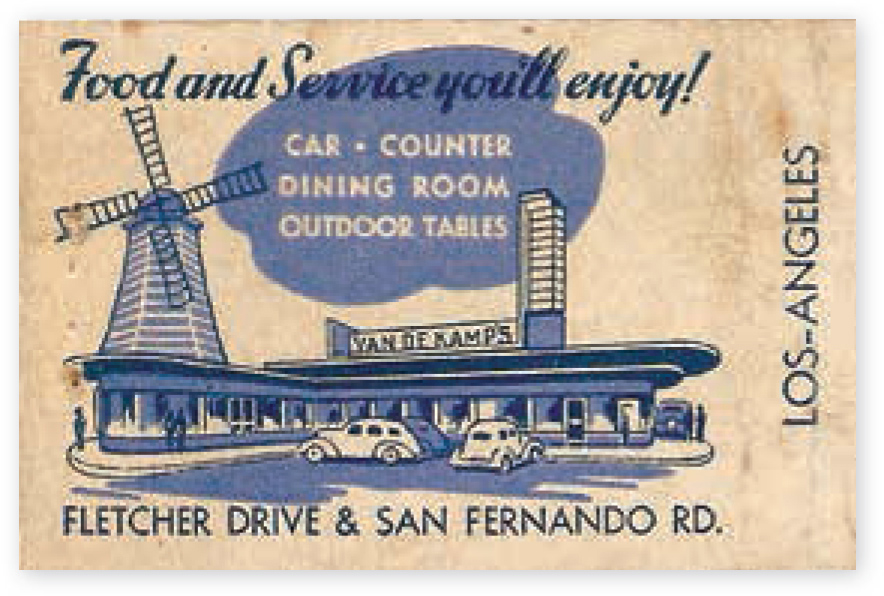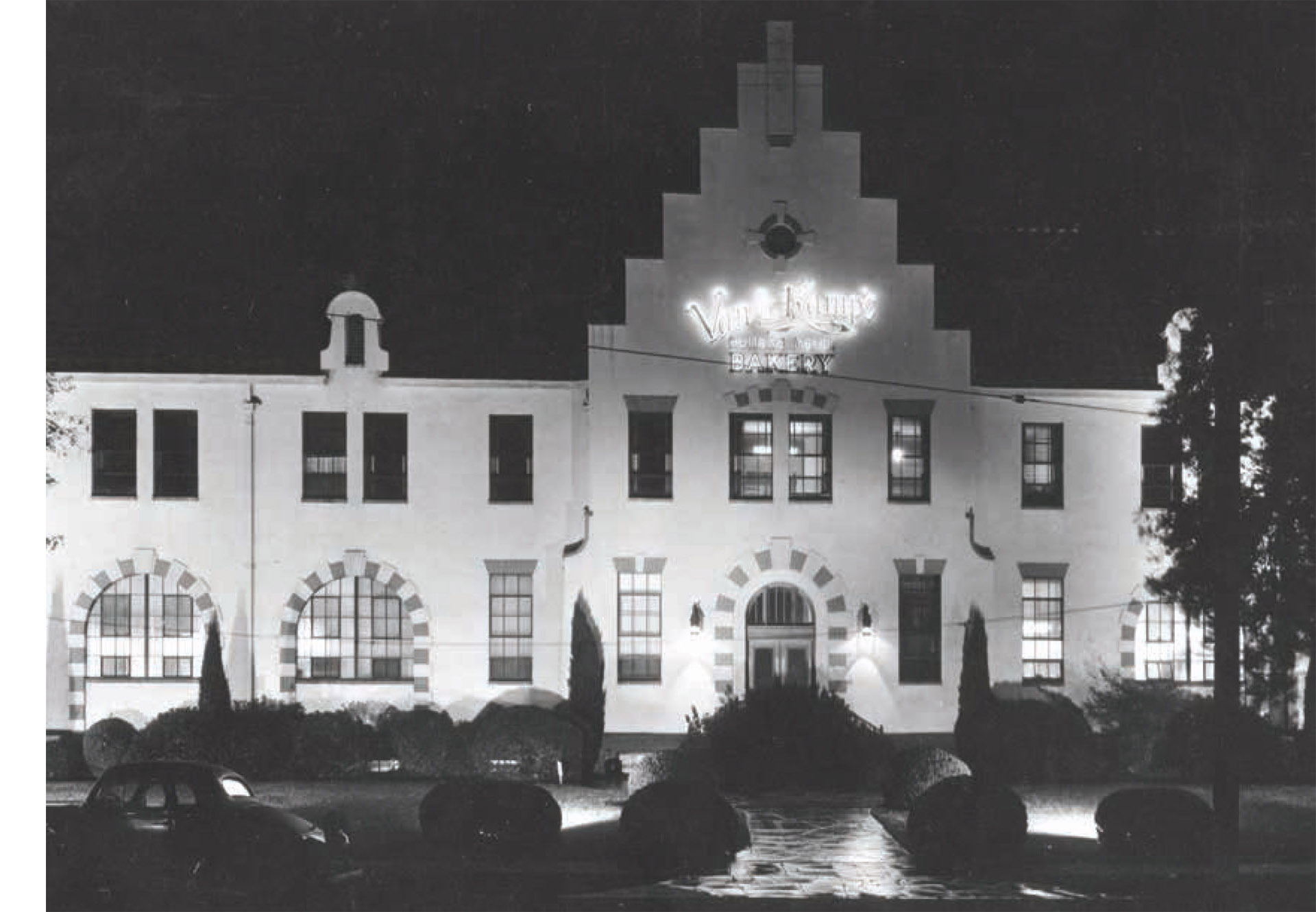Van de Kamp’s Holland Dutch Bakery
OPEN: 1915–1990
LOCATION: 2930 Fletcher Drive Los Angeles, CA 90039
ORIGINAL PHONE: AL 3-856 and CL 5-0171
CUISINE: Baked Goods
DESIGN: J. Edwin Hopkins
BUILDING STYLE: Dutch Renaissance Revival
CURRENTLY: Los Angeles City College Van de Kamp Campus

The Van de Kamp’s central production facility on Fletcher Drive, circa 1945.
YOU CAN TELL HOW LONG SOMEONE HAS LIVED IN SOUTHERN CALIFORNIA BY HOW THEY REMEMBER THE VAN DE KAMP’S BRAND. Do you remember it as bakery products sold in stores with packaging that featured windmills and bakery girls wearing traditional “Holland Blue” dresses, white hats, and aprons? Or as fish sticks in the frozen-food section? Or do you remember the Van de Kamp’s restaurants and coffee shops?
I have a personal fondness for the Van de Kamp’s brand. During the holidays, my mother would slice a Van de Kamp’s Date Nut Loaf and arrange the pieces in a spiral on a fancy glass plate for the family to enjoy. In the late 1940s, my grandmother worked as a Van de Kamp’s salesgirl at a Vons market in Santa Monica, which was also where my mother worked in the snack bar. In 1950, my father came into the market to visit his mother while on military leave, and he met my mother. They married a few years later. My aunt also worked as an area supervisor with Van de Kamp’s. While I was in culinary school in 1980, one of our instructors, Mr. Perkowski, was the lead decorator at the Van de Kamp’s plant on Fletcher Drive and took all of us on a tour of the three-story building. I got to see the production of butter sprinkle cookies, my favorite as a kid.
In 1915, Theodore Van de Kamp and his brother-in-law, Lawrence “Lawry” Frank, started a potato chip business in downtown Los Angeles called Saratoga Chips, employing their wives, Marion and Henrietta, as the sales staff. Due to a shortage of potatoes, they were soon forced to diversify into other products. Within a year, Van de Kamp’s Holland Dutch Bakeries was born, and by 1921, a full-scale retail bakery was in operation at 408 N. Western Avenue, serving made-to-order cakes, cookies, pies, and flaky yeast breads. The family created a total of 140 different recipes for baked goods. Later on, they also founded the Tam O’Shanter Inn in 1922 (see page 45), Lawry’s The Prime Rib in 1938, and Lawry’s California Center in 1953 (page 197).
Frank and Van de Kamp needed something to catch the attention of the drivers speeding along Western Avenue and draw them into the shop, so they attached a large windmill to the roof of their bakery building, designed by art director Harry Oliver. Following the Dutch theme, the Van de Kamp’s salesgirls wore blue dresses, starched laced aprons, and white hats. In 1923, they opened their first coffee shop at 600 S. Spring Street, where the twelve-story Alexandria Hotel annex now sits (it has since been converted into lofts).

Postcard showing a Van de Kamp’s shop in Los Angeles, topped with the bakery’s signature windmill, 1947.
By 1929, the original Van de Kamp’s store had grown into a chain, with more than ninety-five locations in the Los Angeles area. The family then opened a central production facility on Fletcher Drive. Later, they added a coffee shop on the corner of the Fletcher Drive property, the first of a chain of coffee shop locations around Southern California.
When Theodore Van de Kamp passed away in 1956, the Van de Kamp family sold the bakery to the General Baking Company, which also controlled Lawry’s Restaurants, Inc., and a number of other food ventures. As a result, Lawrence Frank devoted more time to the Lawry’s spices at the California Center and Lawry’s The Prime Rib on La Cienega Boulevard. In 1979, the company was sold to private investors.
In September 1990, Van de Kamp’s Holland Dutch Bakeries filed for bankruptcy. The original 1929 manufacturing plant on Fletcher Drive closed its doors, putting 500 bakers, plant workers, and office staff members out of work. On May 12, 1992, the building was designated as a Historic-Cultural Monument by the City of Los Angeles. It underwent a $72 million renovation by the Los Angeles Community College District, which opened it as the Van de Kamp satellite campus of Los Angeles City College.
Over the years, the Van de Kamp’s brand has been owned by Pillsbury, Aurora Foods, Pet, Inc., and Van de Kamp’s, Inc. Today, the trademarks are owned by Pinnacle Foods Group. The Van de Kamp’s brand is also used by Kroger, the West Coast’s Ralphs chain, for its line of private-label baked goods.
Many of the newer Van de Kamp’s coffee shop buildings were designed by architect Wayne McAllister, whose creations ranged from Las Vegas casinos to steak houses. The Van de Kamp’s structures, complete with their windmills, could be seen from miles away. They were originally more whimsical-looking, but McAllister updated them, redesigning them in the Googie style. Today, a Denny’s restaurant at 7 E. Huntington Drive in Arcadia (on Route 66) now occupies the only fully intact Van de Kamp’s restaurant structure left in Southern California. 
![]()

Regional manager Bernice Miles (right) with a salesgirl at a Van de Kamp’s shop.

The Van de Kamp’s float, which won the grand prize in the Pasadena Tournament of Roses Parade, circa 1940.


The Van de Kamp’s bakery on Fletcher Drive, where the first Van de Kamp’s coffee shop was opened, circa 1945.
